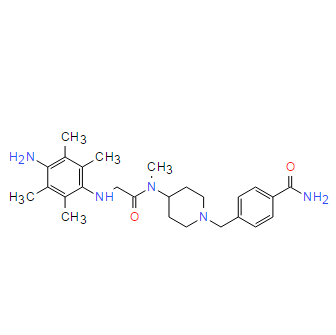| DC28032 |
EMI1 (EGFR MaMTH Inhibitor 1)
|
EMI1 (EGFR MaMTH Inhibitor 1) is a novel EGFR ex19del/T790M/C797S inhibitor.EMI1, while potently reducing the interaction of EGFR triple mutant with Shc1 in our MaMTH-DS assay, did not behave as a TKI and displayed no inhibition of the kinase activity of EGFR triple-mutant protein invitro.EMI1 did, however, more strongly inhibit the viability and increase the caspase 3/7 activ-ity of PC9 EGFR ex19del/T790M/C797S triple-mutant cells than noncancerous human bronchial epithelial (HBE) cells, as well as potently reduce PC9 EGFR ex19del/T790M/C797S organ-oid viability.EMI1 had a similar inhibi-tory effect on microtubule plus-end growth in both EGFR-WT and EGFR-C797S triple-mutant cells at 50–100 nM concentration. At 1 µM concentration, EMI1 strongly depolymerized inter-phase microtubules, perturbed spindle formation and induced strong mitotic block in PC9 EGFR ex19del/T790M/C797S cells after 20 h of treatment. EMI1 inhibited interaction of both proteins with EGFR at a level similar to that observed with Shc1, indicating it is not a specific inhibitor of the EGFR-Shc1 PPI interface. Rather, the loss of interaction mediated by EMI1 appears to be due to a more general alteration in EGFR activity.EMI1 induced EGFR degradation, and inhibited the activation of EGFR, ERK, AKT and S6 in PC9-ex19del and PC9-ex19del/T790M cells. |
| DC42424 |
CPL304110
|
CPL304110 is a potent, orally active and selective of fibroblast growth factor receptors FGFR (1-3), with IC50 values of 0.75 nM, 0.5 nM, and 3.05 nM for FGFR (1-3), respectively. |
| DC11089 |
TAS-120 (Futibatinib)
|
TAS-120 is a highly potent and selective irreversible FGFR inhibitor, effective in tumors harboring various FGFR gene abnormalities. |
| DC10271 |
SUN11602
|
SUN11602 is a novel aniline compound, which mimics the neuroprotective mechanisms of basic fibroblast growth factor. |
| DC7508 |
SU 5402
|
SU5402(SU-5402; SU5402) is potent and selective vascular endothelial growth factor receptor (VEGFR) and fibroblast growth factor receptor (FGFR) inhibitor. (IC50 values are 0.02, 0.03, 0.51 and > 100 μM at VEGFR2, FGFR1, PDGFRβ and EGFR respectively). |
| DC2054 |
PD-173074
|
PD173074 is a potent FGFR1 inhibitor with IC50 of ~25 nM and also inhibits VEGFR2 with IC50 of 100-200 nM. |
| DC10068 |
PD166866
|
PD-166866 is a selective inhibitor of the FGF-1 receptor tyrosine kinase (FGFR1) with IC50 = 55 nM, and no effect on c-Src, PDGFR-b, EGFR or insulin receptor tyrosine kinases or MEK, PKC, and CDK4. |
| DC7019 |
LY-2874455
|
LY2874455 is a novel and potent FGF/FGFR inhibitor. |
| DC10033 |
H3B-6527
|
H3B-6527 is an orally bioavailable inhibitor of human fibroblast growth factor receptor 4 (FGFR4), with potential antineoplastic activity. |
| DC9642 |
FIIN-3
|
FIIN-3 is a potent, selective, irreversible and the next-generation covalent FGFR inhibitor. |






















